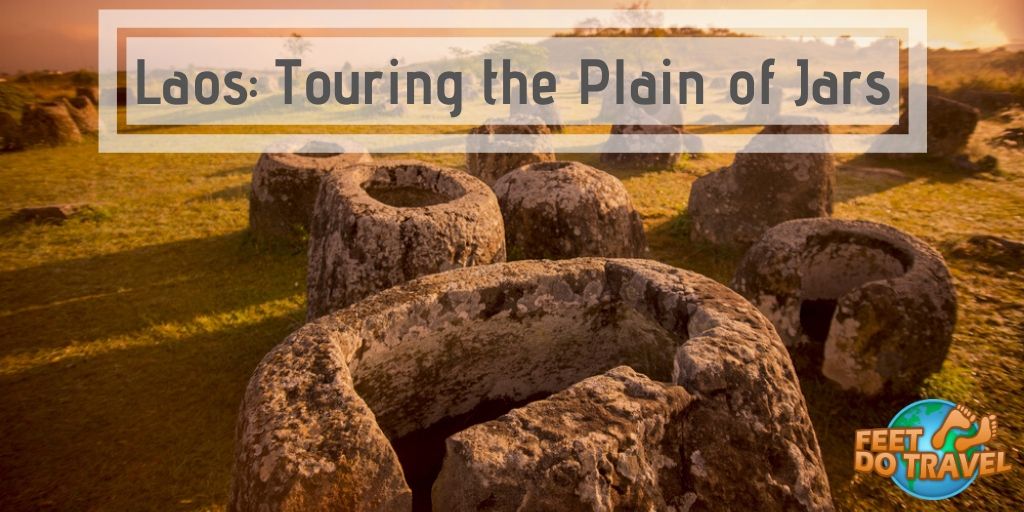The Plain of Jars is one of Laos’ great mysteries. These large stone structures, which are scattered over a vast area in Phonsavan, part of the Xieng Khouang plain in the Lao Highlands, are shrouded in myths and local legend. No one truly knows their origin, but there are many theories as to why they were built and what they were used for.
Dating back to the Iron Age (500 BC to AD 500), they appear in clusters of between a few and several hundred, vary in height between 1-3 metres (3-10 feet), and weigh over a tonne each.
Sometimes referred to as Southeast Asia’s equivalent to Stonehenge, the plain of jars is one of the most important prehistoric sites, and are an archaeological discovery you shouldn’t miss.
Let Feet Do Travel take you to Laos, and a tour of the Plain of jars.
Dating back to the Iron Age (500 BC to AD 500), they appear in clusters of between a few and several hundred, vary in height between 1-3 metres (3-10 feet), and weigh over a tonne each.
Sometimes referred to as Southeast Asia’s equivalent to Stonehenge, the plain of jars is one of the most important prehistoric sites, and are an archaeological discovery you shouldn’t miss.
Let Feet Do Travel take you to Laos, and a tour of the Plain of jars.
Theories and legends surrounding Plain of Jars
Before 1930, very little was known about the Plain of Jars by foreign visitors. French archaeologist Madeleine Colani was surveying a cave close to where the jars are located, and discovered human remains. Around the site, burnt teeth and bones were found supporting the theory the area was used as a crematorium. Researchers believe that the jars were used as funeral urns.
Local Loatian legend, however, says the jars were created by an ancient ruler, the King of the Giants Khun Cheung, to brew and store wine to celebrate battle victories.
Although the plain of Xieng Khouang is seemingly the epicentre of the jars site, there have been other similar sites all of which appear to form a linear path connecting this region to Northern India. It is believed that these jars might have been scattered all over the Asian continent as a result of trade.
Some researchers are of the opinion that the jars were used as watering points by caravan travellers in the dry season. The travellers would leave behind offerings such as jewellery and beads in the jars after they had used the water inside them, however at the time of Colani’s discovery, these all appear to have been looted. Some of the artefacts Colani discovered can be dated to as far back as 500 BC to 800 AD. Her findings have been published in “The Megaliths of Upper Laos.”
Researchers, who have studied the jars in Phonsavan, are of the opinion that they originated from a quarry just a few miles outside the capital. This is the same area that was extensively used by the Lao Nation during the duration of the war.
Deadly remnants of The Secret War
Caretakers of the Plain of Jars are advocating for the area to be adopted as a UNESCO World Heritage site, however before this can happen, a lot of work needs to be done to make the site safe.
The plain of jars is a dangerous archaeological site with an estimated 250,000 active bombs still hidden following the 1960’s Loatian Civil War (“The Secret War”). This area is one of the world’s most heavily bombed, and many organisations based here are on a mission to remove all the explosives. Due to the high risk of visiting this site, despite there being over 90 jar sites, only three are safe and open to tours.
You will pass several craters created by bomb explosions when accessing the many jar sites around the Xieng Khouang plain. Bomb casings are a popular indoor and outdoor decoration in nearby Phonsavan, and many people are involved in the business of scrap metal dealing.
Site 1 is arguably the busiest and most visited by tourists; it is not only relatively close to the city but contains a museum and visitor centre where you can learn more of the history and evolution of the jars.
Sites 2 and 3 are less busy and you could be the only visitor here all day. It is recommended you hire a local guide to tour these two sites, because access is through private properties.
For a viewpoint of the entire plain, take a hiking trail through a pine forest from site 2.
You will need a visa to enter Laos, for Laos Visa Information Check here.
There are many reasons why you should visit the plain of jars, and we hope we have now piqued your interest.
Before 1930, very little was known about the Plain of Jars by foreign visitors. French archaeologist Madeleine Colani was surveying a cave close to where the jars are located, and discovered human remains. Around the site, burnt teeth and bones were found supporting the theory the area was used as a crematorium. Researchers believe that the jars were used as funeral urns.
Local Loatian legend, however, says the jars were created by an ancient ruler, the King of the Giants Khun Cheung, to brew and store wine to celebrate battle victories.
Although the plain of Xieng Khouang is seemingly the epicentre of the jars site, there have been other similar sites all of which appear to form a linear path connecting this region to Northern India. It is believed that these jars might have been scattered all over the Asian continent as a result of trade.
Some researchers are of the opinion that the jars were used as watering points by caravan travellers in the dry season. The travellers would leave behind offerings such as jewellery and beads in the jars after they had used the water inside them, however at the time of Colani’s discovery, these all appear to have been looted. Some of the artefacts Colani discovered can be dated to as far back as 500 BC to 800 AD. Her findings have been published in “The Megaliths of Upper Laos.”
Researchers, who have studied the jars in Phonsavan, are of the opinion that they originated from a quarry just a few miles outside the capital. This is the same area that was extensively used by the Lao Nation during the duration of the war.
Deadly remnants of The Secret War
Caretakers of the Plain of Jars are advocating for the area to be adopted as a UNESCO World Heritage site, however before this can happen, a lot of work needs to be done to make the site safe.
The plain of jars is a dangerous archaeological site with an estimated 250,000 active bombs still hidden following the 1960’s Loatian Civil War (“The Secret War”). This area is one of the world’s most heavily bombed, and many organisations based here are on a mission to remove all the explosives. Due to the high risk of visiting this site, despite there being over 90 jar sites, only three are safe and open to tours.
You will pass several craters created by bomb explosions when accessing the many jar sites around the Xieng Khouang plain. Bomb casings are a popular indoor and outdoor decoration in nearby Phonsavan, and many people are involved in the business of scrap metal dealing.
Site 1 is arguably the busiest and most visited by tourists; it is not only relatively close to the city but contains a museum and visitor centre where you can learn more of the history and evolution of the jars.
Sites 2 and 3 are less busy and you could be the only visitor here all day. It is recommended you hire a local guide to tour these two sites, because access is through private properties.
For a viewpoint of the entire plain, take a hiking trail through a pine forest from site 2.
You will need a visa to enter Laos, for Laos Visa Information Check here.
There are many reasons why you should visit the plain of jars, and we hope we have now piqued your interest.







